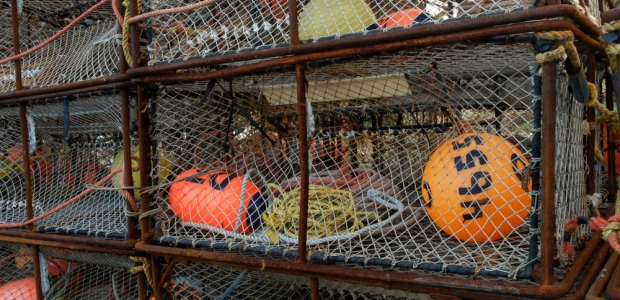
NIOSH Finds Bering Sea/Aleutian Island Crab Fleet's Safety Much Improved
During the 1990s, it was the most hazardous commerical fishery in the United States, with 73 crew members killed on the job.
A new NIOSH report shows that safety in the Bering Sea/Aleutian Island crab fleet has greatly improved since the 1990s, when it was far from safe for the crews working that fishery. It was the most hazardous commercial fishery in the United States at that time, with 73 crew members killed on the job from vessel disasters, falls overboard, or on-board injuries.
The report prepared by Devin Lucas, Ph.D., Samantha Case, MPH, Theodore Teske, MA, Alexis DeLeon, BS, and Dimitreus Kloczko, BFA ("Assessment of Safety in the Bering Sea/Aleutian Island Crab Fleet," DHHS (NIOSH) Publication No. 2016-112) shows that between 2005/06 and 2012/13, 65 injuries in the fleet were reported to the Coast Guard, one of which one was fatal. The other 64 injuries ranged from minor to severe, but most were minor or moderate. Twelve injuries were classified as serious and one as a severe injury, but no critical injuries were reported during the study period, according to their report.
The report's authors write that several factors contributed to the improvement. "Although safety regulations in place at that time required vessels to carry lifesaving equipment, such as immersion suits and life rafts, the regulations did not address the problem of overloading vessels with crab pots, a major cause of vessel disasters and deaths," they report. "This gap in safety regulations was partially corrected by the Coast Guard in 1999 with the introduction of the 'At-the-Dock Stability and Safety Compliance Check' program, in which Coast Guard personnel checked crab vessels in Dutch Harbor prior to departure to ensure that each was loaded in compliance with their stability instructions." This caused fatalities to drop. In addition, the fleet changed in 2005 from a derby-style race for fish to a quota-based (rationalized) system, bringing about an extended fishing season and smaller pot loads and also allowing for a more experienced and potentially less fatigued crew, they found. And consolidation of the fishing fleet, from an average of 243 vessels during 2001-2004 to 78 vessels during 2005-2010 (according to the North Pacific Fishery Management Council) also played a role.
Thus, efforts of the fishing industry, Coast Guard, and National Marine Fisheries Service have all contributed; further improvements in crew member safety may be obtained by analyzing the causes of nonfatal injuries and vessel casualties and developing focused interventions to address hazards, they write.
The 64 nonfatal crew injuries during 2005/06 to 2012/13 represent an injury rate of 12 injuries per 1,000 FTEs. Most of the injuries occurred to deckhands (39/50, 78 percent), followed by processors (7, 14 percent), and engineers (3, 6 percent). Fractures were the most frequently reported injury (12/57, 21 percent), of which half occurred while crew members were handling gear on deck; other commonly reported injuries included contusions (11, 19 percent), lacerations (10, 18 percent), and sprains, strains, and tears (8, 14 percent).
Nine (26 percent) of the vessel casualties during the study period were classified as serious, meaning the vessel had to be rescued at sea and towed to port for repairs, but there were no vessel disasters (e.g., sinking, capsizing) during the study period.